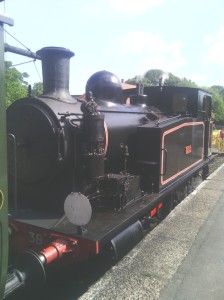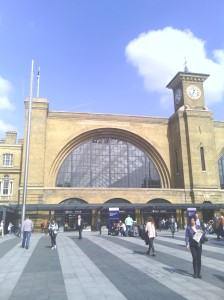
Do you remember The Clash song London Calling? To be fair my headline is not quite how it was. “London calling to the faraway towns” is what they sang. But we all have to start somewhere, to mis-quote Spike Milligan, and that is how I am starting this blog.
Regular readers will know that my wife Kathie Touin and I moved to Orkney from London. Time races on and we’ve been in the north for nearly four-and-a-half wonderful years. Our only return visits to London have been travelling through Heathrow Airport, and one brief overnight stop en route.
But we have just returned from our first proper visit to London since decamping to Orkney. We also spent a week on the Isle of Wight with my father. These are some of my impressions…
For those not familiar with the British Isles, the Isle of Wight is England’s largest island and is situated just off the south coast of England. A few folk thought it funny that we travelled from one of Britain’s most northerly islands to one at the bottom of the map.
The Isle of Wight is a big holiday destination and there is a choice of six ferry services from mainland England. We took the Red Funnel ferry from Southampton to East Cowes. There is plenty of shipping to watch on the way, and indeed from the island when you arrive – everything from gigantic container ships to tiny sailing boats.
The island is busy but in early September not unpleasantly so. Car journeys take time but the traffic moves along steadily. Quieter country roads are narrow and twisty so there’s no opportunity to race along there either.

Our first impression coming from the fresh and breezy atmosphere of Orkney was that the Isle of Wight was too hot and humid, at least for us.
Second impression: in some ways the Isle of Wight feels a little like England in the past – no motorways, small towns, quaint villages, friendly people.
In keeping with this we noticed that old-style Mini cars are still popular on the island – I suppose it makes an ideal runabout but they are becoming pretty rare elsewhere in my experience.
It also seemed to me that there were more people smoking than I remember at home. This may be a false impression created because it was pleasant weather for smokers to stand outside, and they were not huddled out of sight in a windswept corner like they might be in Orkney. But some of the restaurants had outside smoking areas, which surprised me.
The railways on the island are also a throwback. There is the Island Line, part of the National Rail network, operating between Ryde and Shanklin – less than nine miles – and using 1930s London Underground stock. Fantastic.

Meeting the Island Line at Smallbrook Junction is the Isle of Wight Steam Railway, a largely volunteer-run heritage line which goes five-and-a-half miles to Wootton. We had a great day on the steam railway, watching the trains, looking at the restoration projects, travelling up and down the line.
The locomotive in steam was Ajax, built in 1918, requisitioned by the Ministry of Munitions and sent to Persia (modern Iran). She worked there for many years, latterly with the Anglo-Persian Oil Company, before returning to England and working at various industrial locations until 1968.

Among the other island attractions we visited were: the Isle of Wight Bus Museum, where you get to sit on the old buses, not just admire them; Dimbola Lodge, home of Victorian photographer Julia Margaret Cameron, which was hosting an exhibition of Chris Packham’s photographs, and which – as a hotel – hosted Jimi Hendrix when he played the 1970 Isle of Wight Festival, hence his statue in the garden; Waltzing Waters, which has to be seen to be believed, a choreographed water fountains theatre show set to lights and music; and we took a cruise to Portsmouth harbour on a glorious sunny day, watching the scenery and the boats, including Royal Navy ships.

We could have done much more but we were too busy doing nothing much other than watching the sea and the ships, and enjoying some of the island’s lovely food. Crab salad, anyone?
Our week was soon over and we were off to London from Southampton by train, via an overnight stop seeing friends in Horsham, West Sussex. We arrived in London at Victoria station and the immediate impression walking onto the concourse was noise. Really loud noise. Our time in Orkney has acquainted us with a quieter life and we were not prepared for this.
Because there was no Northern Line (weekend engineering work) we took a number 82 bus from outside the station, almost to our friends’ front door in North Finchley. This was a happy accident as travelling by bus allows you to see the world. Kathie told me off for constantly pointing at the sights. “People will think you’re a tourist,” she said. Truth is, I am now, London is no longer home.
We spotted some fantastic sculptures that were new to us: a huge horse’s head at Marble Arch; a life-size bear, recently installed just off Oxford Street, see video (not mine) above; and the beautifully poignant Animals In War Memorial, unveiled in 2004 but which somehow passed me by when I lived in London. Later that day my friend told me she cries every time she sees this.


The following day we travelled from North London on the Piccadilly Line – our first Tube journey in a long time – to our home for the next three nights, Ealing. In fact, we stayed not far from our old flat and on the first evening went back to our favourite local restaurant, Monty’s on Northfield Avenue.
Looking out the next morning into the garden of our friend’s house there was wildlife which we do not see at home in Orkney: a magpie, playing with stones; a grey squirrel, running along the fence; and, in a tree just beyond the fence, a ring-necked parakeet, now a familiar sight and sound in Ealing – they are extremely noisy, but great to see.
I was also struck walking around the Northfields area of Ealing to see appeal notices and countless yellow ribbons tied to lamp-posts for missing teenager Alice Gross. She was last seen not far away near the Grand Union Canal on 28 August. Sadly, as I write, there is still no news.
Later in the trip we visited the main shopping area at Ealing Broadway, still recognisable after more than four years away though there is lots of development taking place. Sadly, this does not seem to include the old cinema which remains as it was when we left – a front wall, held up by a huge iron structure, but everything behind flattened. I hope one day the front of this classic cinema will be revealed again in all its glory.
What else did we do in London?
We visited an old BBC haunt of mine, Albertine’s wine bar in Shepherds Bush, near Television Centre, for a get-together with former work colleagues. It was great to meet folk and swap stories, jokes and memories. And, as someone said, the wine bar is “refreshingly unchanged” – it is friendly and homely, a quiet oasis in a busy city.

We visited Broadcasting House, the headquarters of the BBC, where our friend (a member of staff) was able to show us around the new part of the building, familiar to TV viewers from the comedy W1A and the BBC News. We saw inside the BBC newsroom and were lucky to stand – very still and quietly – in the news gallery, watching the news being broadcast live by a remarkably calm team.
We took a tube to King’s Cross/St Pancras and witnessed the remarkable transformation taking place in the area. When I was first in London in the mid-Eighties I would drive through here with the car doors locked and, if on foot, I certainly would not hang about outside the stations. It was a run-down area known for drug-dealing and prostitution.

Now it is almost continental, both King’s Cross and St Pancras stations are tastefully modernised, the fabulous St Pancras Hotel is restored and open, as is the Great Northern Hotel, and there are people meeting, talking, laughing, getting lunch from the cafes.
And behind the stations is an enormous redevelopment site of which I suspect we saw only a small part. For example, the University of the Arts London is housed in a former granary building – which once held Lincolnshire wheat for London’s bakers – now restored with fountains in the front. Nearby we crossed a bridge over the Regent’s Canal.

A couple of general observations: I had forgotten how grubby you can feel in London, how you want to wash your hands – at least I do – after each tube journey. But, speaking of tube journeys, they are becoming more comfortable. On the Hammersmith & City line we travelled on pleasant new air-conditioned trains which are also walk-through from end to end. They are gradually being introduced throughout the network. And the buses in London are modern and comfortable: while at King’s Cross we took a ride on one of the New Routemaster buses, also known as Borisbuses and – here’s a throwback – they have conductors.

Finally, I must mention our brushes with fame in London…
While at King’s Cross we visited Kathie’s friend Adam Helal at his recording studio in Tileyard, then took lunch with him at the Vinyl Cafe next door, along with the charming Andrew Wincott who was recording an audio book with Adam. Andrew is perhaps best known as Adam (another one) in The Archers.

And on the last night of our trip to England we went to the Hammersmith Apollo to see the masterful Kate Bush in concert – I suspect you will read more about this on Kathie’s blog at a future date. My modest capacity with words does not stretch to arts criticism, and I don’t want to spoil the event for those still to go. Suffice to say it was a wonderful evening, Kate was in great voice, the audience loved her, the show was imaginative, theatrical, and the band was great. On a few occasions I even found tears welling up – an emotional final evening to round off our visit to England.
Graham Brown
PS There are more photographs from the trip on my Instagram account: http://instagram.com/grahambrownorkney
To find out more
Wikipedia on the Isle of Wight: http://en.wikipedia.org/wiki/Isle_of_Wight
Isle of Wight Steam Railway: http://www.iwsteamrailway.co.uk/
Isle of Wight Bus Museum: http://www.iwbusmuseum.org.uk/
Dimbola Museum & Galleries: http://www.dimbola.co.uk/
Waltzing Waters: http://www.waltzingwaters.co.uk/
Animals In War memorial: http://www.animalsinwar.org.uk/
Albertine wine bar on Twitter: https://twitter.com/AlbertineWine
Broadcasting House: http://www.bbc.co.uk/broadcastinghouse/
New-look King’s Cross: http://www.kingscross.co.uk/
Kate Bush: https://www.katebush.com/

